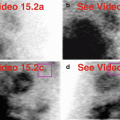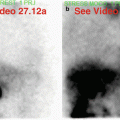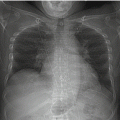and Vincent L. Sorrell2
(1)
Division of Nuclear Medicine and Molecular Imaging Department of Radiology, University of Kentucky, Lexington, Kentucky, USA
(2)
Division of Cardiovascular Medicine Department of Internal Medicine Gill Heart Institute, University of Kentucky, Lexington, Kentucky, USA
Electronic supplementary material
The online version of this chapter (doi: 10.1007/978-3-319-25436-4_26) contains supplementary material, which is available to authorized users.
Vascular-related imaging artifacts in the abdomen are similar to those in the chest and are listed in Table 26.1. The injection site might overlie the abdomen; it might appear focal (Fig. 26.1) or may be more linear if radiopharmaceutical is retained in catheter tubing or if extravasation occurred (Fig. 26.2). Care should be given to ensure that the injection site and the arms are moved away from the body to avoid subsequent processing artifacts (Chamarthy and Travin 2010; Gentili et al. 1994; Strauss et al. 2008). Except to qualify the diagnostic quality of the examination, reporting vascular system findings is generally not clinically warranted.
Table 26.1
Differential diagnosis of “hot” and “cold” imaging findings related to the vascular system
Organ system | “Hot” finding | “Cold” finding | References |
|---|---|---|---|
Vascular system | Contamination from injection/extravasation at injection site | Not reported | Chamarthy and Travin (2010)
Stay updated, free articles. Join our Telegram channel
Full access? Get Clinical Tree
 Get Clinical Tree app for offline access
Get Clinical Tree app for offline access

|





